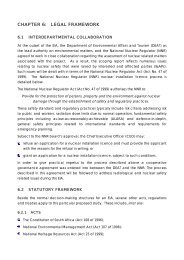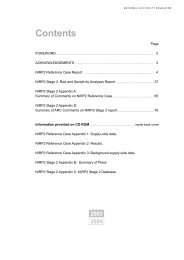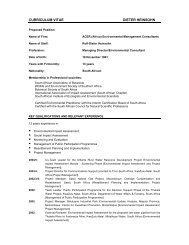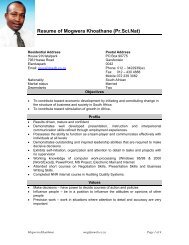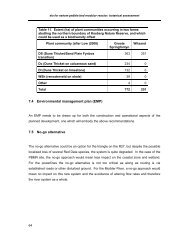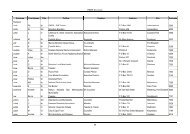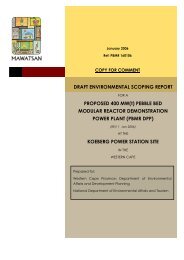Pebble Bed Modular Reactor Demonstration Power Plant (PBMR ...
Pebble Bed Modular Reactor Demonstration Power Plant (PBMR ...
Pebble Bed Modular Reactor Demonstration Power Plant (PBMR ...
You also want an ePaper? Increase the reach of your titles
YUMPU automatically turns print PDFs into web optimized ePapers that Google loves.
BACKGROUND INFORMATION DOCUMENT<br />
Environmental Impact Assessment<br />
for the Proposed 400 MW(t) <strong>Pebble</strong><br />
<strong>Bed</strong> <strong>Modular</strong> <strong>Reactor</strong> <strong>Demonstration</strong><br />
<strong>Power</strong> <strong>Plant</strong> (<strong>PBMR</strong> DPP) on the<br />
Koeberg <strong>Power</strong> Station site in the<br />
Western Cape<br />
November 2005<br />
1
1. INTRODUCTION<br />
Eskom proposes to construct, commission, operate, maintain and decommission a<br />
<strong>Pebble</strong> <strong>Bed</strong> <strong>Modular</strong> <strong>Reactor</strong> (<strong>PBMR</strong>) <strong>Demonstration</strong> <strong>Power</strong> <strong>Plant</strong> (DPP) with a<br />
nominal thermal output of 400 MW to assess the technological, environmental and<br />
socio-economic viability of the technology.<br />
The proposed project is in response to:<br />
<br />
Assessments of the projected electricity demand and supply in South Africa:<br />
The Department of Minerals and Energy performs Integrated Energy Planning to<br />
identify future energy demand and supply requirements. The National<br />
Electricity Regulator (NER) performs National Integrated Resource Planning to<br />
identify the future electricity demand and supply requirements. Similarly Eskom<br />
assesses the projected electricity demand and supply through a process called<br />
the Integrated Strategic Electricity Plan. Through these processes, the most<br />
likely future electricity demand is forecast based on long-term Southern African<br />
economic scenarios. This information provides the framework for Eskom and<br />
South Africa to investigate a wide range of supply and demand-side<br />
technologies and options. This planning process identified that South Africa will<br />
require additional “peaking electricity generating capacity” by 2007 and<br />
additional “base load electricity generating capacity” by 2010.<br />
<br />
<br />
In the longer term (2020 and beyond), the existing power stations will start to<br />
come to the end of their useful life, hence replacement power stations will be<br />
required over and above those required to cater for growth in demand.<br />
As part of an ongoing effort to evaluate the viability of all supply-side options, a<br />
number of power generation technologies, not yet implemented in South Africa<br />
on a commercial basis, are being evaluated in terms of technical, socioeconomic<br />
and environmental aspects. These research, development and<br />
demonstration investigations include:<br />
♦<br />
♦<br />
♦<br />
♦<br />
♦<br />
♦<br />
Underground high head pumped storage (hydro) schemes using worked out<br />
mines.<br />
Underground coal gasification.<br />
Ultra Fines coal.<br />
Wind energy.<br />
<strong>Pebble</strong> <strong>Bed</strong> <strong>Modular</strong> <strong>Reactor</strong> (<strong>PBMR</strong>) technology.<br />
A solar thermal power plant.<br />
♦ Photovoltaic and biomass gasification applications as part of the<br />
Government’s Integrated Rural Development Programme.<br />
Preliminary results of these studies indicate that it is necessary to validate the<br />
assumptions and modelling of some of these options through demonstration/ pilot<br />
2
plants. The research and demonstration period for new technologies may take a<br />
number of years to consider the long-term technical, operational and socioeconomic<br />
aspects. A demonstration/ pilot plant would provide sufficient information<br />
to make a decision on the commercial use of a technology.<br />
The proposed <strong>PBMR</strong> DPP is one of these demonstrations. Other demonstration/pilot<br />
plants either already in operation or in the feasibility planning stage include largescale<br />
solar thermal technology, a wind demonstration facility, biomass gasification<br />
and underground coal gasification.<br />
While individual aspects of the technologies used in the <strong>PBMR</strong> DPP have already<br />
been proven by various projects throughout the world, one of the purposes of this<br />
project is to demonstrate the integration of these technologies, within the South<br />
African energy mix.<br />
The proposed activity consists of the construction, commissioning, operation and<br />
maintenance and decommissioning of a <strong>Pebble</strong> <strong>Bed</strong> <strong>Modular</strong> <strong>Reactor</strong> (<strong>PBMR</strong>)<br />
<strong>Demonstration</strong> <strong>Power</strong> <strong>Plant</strong> (DPP) with a nominal thermal output of 400 MW(t).<br />
2. BACKGROUND INFORMATION<br />
A comprehensive EIA has already been conducted for a similar project. The<br />
following paragraphs provide information on the previous EIA, as well as on its<br />
relationship to the current process.<br />
The original intention of Eskom was to build a 302 MW(t) <strong>PBMR</strong> <strong>Demonstration</strong> <strong>Plant</strong><br />
on the Koeberg Site. An environmental impact assessment for this plant<br />
commenced in 1999 when Eskom appointed a consortium of independent<br />
consultants to perform the EIA. An extensive scoping and special study programme<br />
was undertaken, including comprehensive public participation through numerous<br />
interactions (focus group meetings, open days and public meetings), with periods for<br />
comment being provided during the Scoping and EIA phases. This culminated in the<br />
submission of the Final Environmental Impact Report to the Department of<br />
Environmental Affairs and Tourism (DEAT) in October 2002. The evaluation of the Final<br />
EIR by DEAT and an International Review Panel appointed by DEAT was undertaken,<br />
leading to the issuing of a positive Record of Decision by the DEAT Director-General<br />
in June 2003.<br />
Appeals against the Record of Decision were submitted to the DEAT Minister during<br />
July and August 2003.<br />
An application was brought before the Cape High Court on behalf of Earthlife Africa<br />
(Cape Town) in September 2003 to have the Record of Decision issued by the DEAT<br />
DG reviewed and set aside. The Court judgement was handed down in January<br />
2005. In this judgement the Cape High Court ruled in favour of the application, set<br />
aside the Record of Decision, and required the DEAT DG “ …. to afford the applicant<br />
and other interested parties an opportunity of addressing further written submissions<br />
3
to him along the lines as set out in this judgment and within such period as he may<br />
determine and to consider such submissions before making a decision anew on the<br />
second respondent’s application.”<br />
Since the completion of this EIA, the decision was made to increase the power<br />
output of the DPP from 302 MW(t) to 400 MW(t). This change in output requires that a<br />
new EIA application process be launched.<br />
All the environmental impacts of the 400 MW(t) <strong>PBMR</strong> DPP will be identified and<br />
assessed. Information sourced during the “302 MW (t) <strong>PBMR</strong> EIA” will be considered<br />
where relevant and appropriate. All relevant information will be included into the<br />
scoping process.<br />
All issues and comments raised during the public participation process will be noted,<br />
incorporated into an issues and response register and incorporated into the scoping<br />
report. This includes issues raised during meetings, in writing, telephonically or during<br />
interviews and discussions. As indicated previously, I&APS will have an opportunity to<br />
review the scoping report to verify the accuracy and completeness of the issues<br />
raised by them.<br />
3. THE PROPOSED ACTIVITY<br />
The proposed <strong>PBMR</strong> DPP is a graphite moderated, helium cooled, nuclear reactor,<br />
configured as an electricity generating power station. The <strong>PBMR</strong> DPP uses a direct<br />
gas turbine cycle to convert the heat, generated by nuclear fission in the reactor<br />
and transferred to the helium coolant, into electrical energy by means of a<br />
horizontally configured turbo-generator.<br />
Fuel for the proposed <strong>PBMR</strong> DPP would consist of spherical pebbles (approximately<br />
60 mm in diameter) that contain Triso coated Uranium Oxide kernels (up to 10%<br />
enriched), which are embedded in a pure graphite matrix.<br />
Provision will be made to accommodate all spent fuel on the site for the 40 year<br />
design life of the plant subject to statutory prescription. Radioactive waste<br />
(excluding spent fuel) would be managed on site, and disposed of at the Vaalputs<br />
repository, as in the case of the current Koeberg nuclear power plant and in<br />
accordance with statutory prescription.<br />
The proposed <strong>PBMR</strong> DPP will be connected to the Eskom national transmission<br />
network within the Koeberg power station site.<br />
A widening of a portion of the road to the Koeberg power station from the R27<br />
turnoff, and the construction of the internal roads on the Koeberg power station site<br />
for access to the <strong>PBMR</strong> DPP site are also proposed. The proposed <strong>PBMR</strong> DPP would to<br />
a large extent make use of existing Koeberg infrastructure and services.<br />
4
4. THE ENVIRONMENTAL IMPACT ASSESSMENT<br />
PROCESS<br />
Mawatsan is the appointed independent consultant to implement the EIA process.<br />
The following sections provide more detailed information on this process.<br />
4.1 ENVIRONMENTAL IMPACT ASSESSMENT REGULATIONS<br />
In terms of the EIA regulations (Government Notice no's R1182,R1183 and R1184 of<br />
1997 in terms of the Environment Conservation Act, 1989 (Act No. 73 of 1989), there<br />
are a number of listed activities that could potentially have substantial detrimental<br />
effects on the environment and which are required to be subjected to<br />
Environmental Impact Assessment (EIA) processes.<br />
The proposed 400 MW(t) <strong>PBMR</strong> <strong>Demonstration</strong> <strong>Power</strong> <strong>Plant</strong> includes activities that fall<br />
within the ambit of the following listed activities:<br />
Activity 1.<br />
(a)<br />
(b)<br />
(c)<br />
(ii)<br />
(d)<br />
Activity 2.<br />
(c)<br />
The construction, erection or upgrading offacilities<br />
for commercial electricity generation with an output of at least<br />
10 megawatts and infrastructure for bulk supply;<br />
nuclear reactors and facilities for the production, enrichment,<br />
processing, reprocessing, storage or disposal of nuclear fuels and<br />
wastes;<br />
with regard to any substance which is dangerous or hazardous and is<br />
controlled by national legislationmanufacturing,<br />
storage, handling, treatment or processing facilities for<br />
any such substance;<br />
roads, railways, airfields and associated structures;<br />
The change of land use fromagricultural<br />
or zoned undetermined use or an equivalent zoning to any<br />
other land use;<br />
Activity 9. Scheduled processes listed in the Second Schedule to the Atmospheric<br />
Pollution Prevention Act, 1965 (Act No. 45 of 1965):<br />
29. <strong>Power</strong> generation processes: That is to say, processes in which-<br />
(c)<br />
any fuel burning appliance is used that is not controlled in terms of Part<br />
III of this Act, excluding appliances in private dwellings. This activity is<br />
related to the D-generator, which is used as an auxiliary source and for a short<br />
term only. It is not related to the primary generation of electricity<br />
5
4.2 THE STUDY AREA<br />
The proposed <strong>PBMR</strong> DPP will be located at the Koeberg <strong>Power</strong> Station site in the<br />
Western Cape. The Koeberg nuclear power station is situated north of Ouskip, Van<br />
Riebeeckstrand and Melkbosstrand and to the east of the R27 on the farm<br />
Duynefontein 34. The site is located about 2.0 km from the Duynefontein residential<br />
area, 30 km north of Cape Town and 10 km south of Atlantis. The proposed <strong>PBMR</strong><br />
DPP site will be situated within the existing Access Control 1 security fence of the<br />
Koeberg nuclear power station site. It will therefore be on land currently used for<br />
nuclear power generation.<br />
Koeberg<br />
power station<br />
6
Locality of Koeberg power station site and the approximate location<br />
of the proposed <strong>PBMR</strong> DPP on the site<br />
Koeberg<br />
power station<br />
site<br />
Approximate<br />
location of the<br />
proposed<br />
<strong>PBMR</strong> DPP<br />
7
5. THE PUBLIC PARTICIPATION PROCESS<br />
A comprehensive public participation process will be implemented during the<br />
Scoping and EIA phases of the project. The focus will be on informing Interested and<br />
affected parties (I&APs) of the proposed development and of the significant<br />
differences between the 302 MW(t) and 400 MW(t) <strong>PBMR</strong> DPPs. Issues and<br />
comments raised during the previous public participation process will be collated<br />
and incorporated into the Scoping and EIA phases of the current process.<br />
5.1 AIMS OF THE PUBLIC PARTICIPATION PROCESS<br />
Mawatsan will be responsible for the Public Participation Process. The Public<br />
Participation Process is structured to:<br />
<br />
<br />
<br />
<br />
<br />
<br />
Enable early involvement of l&APs in the environmental assessment process<br />
through a variety of mechanisms, adapted as required in response to issues,<br />
concerns and challenges. This involvement will be ongoing until a decision is<br />
reached by the authorities;<br />
Provide l&APs with ongoing information regarding the proposed project and<br />
related impacts;<br />
Ensure continuous transparency and informed decision-making;<br />
Promote communication with l&APs;<br />
Ensure that the l&APs' viewpoints are addressed and considered by the<br />
regulating authorities; and<br />
Facilitate a constructive process that enables l&APs and stakeholders such as<br />
the authorities, project proponents and specialists to work together to enhance<br />
the positive benefits of the project and limit the negative impacts associated<br />
with the project.<br />
5.2 COMPONENTS OF THE PUBLIC PARTICIPATION PROCESS<br />
The public participation process will consist of the following activities:<br />
<br />
<br />
<br />
Notification of I&APs regarding the EIA process, consultation activities and<br />
availability of reports and decisions by the authorities, using a variety of<br />
mechanisms.<br />
Interviews with a variety of I&APs in respect of the <strong>PBMR</strong> demonstration plant.<br />
Focus Group Meetings with relevant sectoral groups (groups of role-players with<br />
similar interests, such as the business sector, tourism, agriculture, local<br />
government, etc.).<br />
8
Public Meetings that will be widely advertised. These will provide I&APs with<br />
information and opportunities to record concerns, issues and suggestions, as<br />
well as to identify other I&APs.<br />
A web-site (www.pbmr-eia.co.za) is available. This containing relevant<br />
project documentation, links to appropriate documentation as well as an<br />
opportunity to make comments and register as I&APs.<br />
5.3 WHY IS YOUR PARTICIPATION IMPORTANT?<br />
Everyone has the right to be involved in decisions that may affect their lives.<br />
Participation by Interested and Affected Parties is in everyone's best interest<br />
because:<br />
It provides opportunities for l&APs and the authorities to obtain clear,<br />
accurate and understandable information about the proposed project;<br />
It provides members of the public with the opportunity to provide comments<br />
(both positive and negative) regarding the environmental impacts of the<br />
proposed project;<br />
It provides affected parties with the opportunity to suggest ways for reducing<br />
or mitigating any negative impacts of the project, or for enhancing its<br />
benefits;<br />
It will enable the project proponent to incorporate the needs, preferences<br />
and values of I&APs into their decisions;<br />
It contributes toward maintaining a healthy, vibrant democracy.<br />
5.4 REGISTERING AS AN INTERESTED AND AFFECTED PARTY<br />
In order to register as an I&AP you are requested to:-<br />
<br />
<br />
<br />
<br />
Respond to the relevant newspaper advertisements,<br />
Complete and submit the registration sheet included in the Background<br />
Information Document;<br />
Attend public events; and<br />
Provide Mawatsan with your contact details.<br />
As a registered I&AP you are entitled to be informed about public events and to<br />
receive project documentation, and to be afforded the opportunity to comment<br />
and raise issues and concerns throughout the process. You will also receive<br />
notifications to inform you of the availability of the Scoping and EIR report and the<br />
opportunity to comment thereon.<br />
On completion of the environmental specialist studies, the Draft Environmental<br />
Impact Report (EIR) will be compiled and made available for public comment. All<br />
9
egistered I&APs will be informed of the availability of this document and the public<br />
meetings to discuss the draft EIR.<br />
If you consider yourself an I&AP for the proposed project, we urge you to make use<br />
of the opportunities created by the Public Participation Process to become<br />
involved.<br />
5.5 PUBLIC MEETING<br />
A number of Public Meetings are scheduled to introduce the proposed project to<br />
l&APs. These events are as follows:<br />
Milneron 9 November 2005 Milnerton Sport Centre at 18h30<br />
Atlantis 10 November 2005: Hartebesskraal Multi Purpose Centre at<br />
18h30<br />
Midrand 15 November 2005 Eskom Convention Centre at 18h30<br />
Durban 17 November 2005 Durban Exhibition Centre at 18h30<br />
The main aim of the public meeting is to provide l&APs with more information on the<br />
proposed project and to explain the process to be followed, note their issues and<br />
concerns and answer questions.<br />
We invite you to attend the public meetings to ensure that you are kept informed of<br />
the project and that your issues and concerns can be formally recorded and<br />
addressed.<br />
10
6. REGISTRATION SHEET<br />
Please complete this form and return it to:<br />
Mawatsan:<br />
Ms. Mathilda du Preez<br />
Tel: 012 362 2908<br />
Fax: 012 362 2463<br />
PO Box 13540, Hatfield, 0028<br />
pbmr@mawatsan.co.za<br />
www.pbmr-eia.co.za<br />
PERSONAL DETAILS<br />
Title: _______ Initials: _______ Surname: ___________________________________________<br />
Organisation/ Firm (if applicable): ______________________________________________<br />
Position/ Nature of involvement (e.g. property owner): ___________________________<br />
_______________________________________________________________________________<br />
Street address:<br />
Postal address:<br />
____________________________________________________________<br />
____________________________________________________________<br />
Tel and area code:<br />
Home:<br />
Fax:<br />
Work:<br />
Cell:<br />
E-mail:<br />
____________________________________________________________<br />
____________________________________________________________<br />
____________________________________________________________<br />
____________________________________________________________<br />
____________________________________________________________<br />
COMMENTS / QUESTIONS<br />
1. What potential impacts do you foresee?<br />
_______________________________________________________________________________<br />
_______________________________________________________________________________<br />
11
2. What issues and concerns would you like to raise with regard to these anticipated<br />
impacts?<br />
_______________________________________________________________________________<br />
_______________________________________________________________________________<br />
_______________________________________________________________________________<br />
_______________________________________________________________________________<br />
3. Are there any role-players that you feel we should consult with (please state their<br />
names a contact details)?<br />
_______________________________________________________________________________<br />
_______________________________________________________________________________<br />
_______________________________________________________________________________<br />
12



